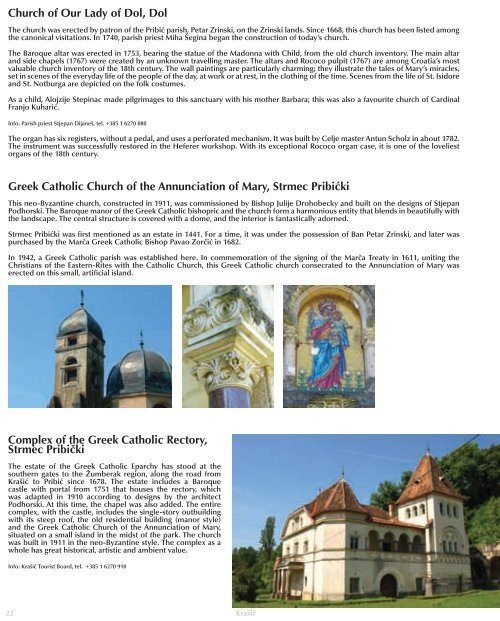The Cultural Heritage of Zagreb County
The Cultural Heritage of Zagreb County
The Cultural Heritage of Zagreb County
You also want an ePaper? Increase the reach of your titles
YUMPU automatically turns print PDFs into web optimized ePapers that Google loves.
Church <strong>of</strong> Our Lady <strong>of</strong> Dol, Dol<br />
<strong>The</strong> church was erected by patron <strong>of</strong> the Pribić parish, Petar Zrinski, on the Zrinski lands. Since 1668, this church has been listed among<br />
the canonical visitations. In 1740, parish priest Miha Šegina began the construction <strong>of</strong> today’s church.<br />
<strong>The</strong> Baroque altar was erected in 1753, bearing the statue <strong>of</strong> the Madonna with Child, from the old church inventory. <strong>The</strong> main altar<br />
and side chapels (1767) were created by an unknown travelling master. <strong>The</strong> altars and Rococo pulpit (1767) are among Croatia’s most<br />
valuable church inventory <strong>of</strong> the 18th century. <strong>The</strong> wall paintings are particularly charming; they illustrate the tales <strong>of</strong> Mary’s miracles,<br />
set in scenes <strong>of</strong> the everyday life <strong>of</strong> the people <strong>of</strong> the day, at work or at rest, in the clothing <strong>of</strong> the time. Scenes from the life <strong>of</strong> St. Isidore<br />
and St. Notburga are depicted on the folk costumes.<br />
As a child, Alojzije Stepinac made pilgrimages to this sanctuary with his mother Barbara; this was also a favourite church <strong>of</strong> Cardinal<br />
Franjo Kuharić.<br />
Info: Parish priest Stjepan Dijaneš, tel. +385 1 6270 080<br />
<strong>The</strong> organ has six registers, without a pedal, and uses a perforated mechanism. It was built by Celje master Antun Scholz in about 1782.<br />
<strong>The</strong> instrument was successfully restored in the Heferer workshop. With its exceptional Rococo organ case, it is one <strong>of</strong> the loveliest<br />
organs <strong>of</strong> the 18th century.<br />
Greek Catholic Church <strong>of</strong> the Annunciation <strong>of</strong> Mary, Strmec Pribićki<br />
This neo-Byzantine church, constructed in 1911, was commissioned by Bishop Julije Drohobecky and built on the designs <strong>of</strong> Stjepan<br />
Podhorski. <strong>The</strong> Baroque manor <strong>of</strong> the Greek Catholic bishopric and the church form a harmonious entity that blends in beautifully with<br />
the landscape. <strong>The</strong> central structure is covered with a dome, and the interior is fantastically adorned.<br />
Strmec Pribićki was first mentioned as an estate in 1441. For a time, it was under the possession <strong>of</strong> Ban Petar Zrinski, and later was<br />
purchased by the Marča Greek Catholic Bishop Pavao Zorčić in 1682.<br />
In 1942, a Greek Catholic parish was established here. In commemoration <strong>of</strong> the signing <strong>of</strong> the Marča Treaty in 1611, uniting the<br />
Christians <strong>of</strong> the Eastern-Rites with the Catholic Church, this Greek Catholic church consecrated to the Annunciation <strong>of</strong> Mary was<br />
erected on this small, artificial island.<br />
Complex <strong>of</strong> the Greek Catholic Rectory,<br />
Strmec Pribički<br />
<strong>The</strong> estate <strong>of</strong> the Greek Catholic Eparchy has stood at the<br />
southern gates to the Žumberak region, along the road from<br />
Krašić to Pribić since 1678. <strong>The</strong> estate includes a Baroque<br />
castle with portal from 1751 that houses the rectory, which<br />
was adapted in 1910 according to designs by the architect<br />
Podhorski. At this time, the chapel was also added. <strong>The</strong> entire<br />
complex, with the castle, includes the single-story outbuilding<br />
with its steep ro<strong>of</strong>, the old residential building (manor style)<br />
and the Greek Catholic Church <strong>of</strong> the Annunciation <strong>of</strong> Mary,<br />
situated on a small island in the midst <strong>of</strong> the park. <strong>The</strong> church<br />
was built in 1911 in the neo-Byzantine style. <strong>The</strong> complex as a<br />
whole has great historical, artistic and ambient value.<br />
Info: Krašić Tourist Board, tel. +385 1 6270 910<br />
22 Krašić



